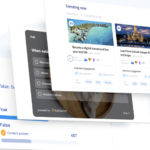The value of internal linking in SEO and revenue cannot be understated. Internal linking refers to the practice of connecting different pages within a website through hyperlinks. This helps search engines understand the structure of the website and improves its visibility in search results.
Internal linking plays a crucial role in enhancing user experience by providing easy navigation and access to relevant information. When done strategically, it can boost the organic rankings of individual pages and drive more traffic to the site.
Furthermore, internal links distribute authority and PageRank throughout the website, strengthening the overall domain authority. As a result, this can positively impact the ranking potential of all linked pages, leading to higher visibility and increased revenue opportunities.
One unique aspect of internal linking is its ability to highlight important pages or content on a website. By using descriptive anchor texts, webmasters can guide search engines to understand the context and relevance of specific pages, thereby improving their chances of ranking for targeted keywords.
In addition, internal linking helps search engine crawlers discover new content on a website more efficiently. By providing clear pathways from established pages to newly created ones, webmasters can facilitate faster indexing and improve the visibility of fresh content in search engine results.
Pro Tip: When implementing internal links, ensure they are natural and contextual. Avoid over-optimizing anchor texts with exact match keywords as this may be seen as spammy by search engines. Focus on creating a seamless user experience while improving your website’s visibility and revenue potential through strategic internal linking.
Understanding Internal Linking
Internal linking is key for SEO and revenue. It means making links inside a website which connect pages and improve user experience, navigation, and search engine rankings. Here’s a table to help understand it better:
| Aspects | Description |
|---|---|
| Benefits | Improved navigation Enhanced user experience Higher page authority Increased search engine rankings |
| Implementation | Relevant anchor text Strategic link placement Proper site structure |
Plus, internal linking shares link equity across website. This helps search engines find and index pages, leading to more organic visibility and more traffic.
Internal linking has been around since the early internet days when Tim Berners-Lee created HTML. As websites grew, webmasters saw the power of connecting pages internally, helping content discoverability and better rankings.
Benefits of Internal Linking
Internal linking is essential for both SEO and revenue growth. Linking different pages within your website can improve user experience and search engine rankings! Here are the main advantages of internal linking:
- Helps website navigation: Internal links enable users to explore your website effortlessly. This leads to longer browsing sessions and higher engagement.
- Improves crawlability: Search engines use internal links to index web pages. Anchor text in your internal links can help search engine bots find important pages.
- Spreads link equity: Internal linking spreads link authority around your website. Linking lower-ranking pages to high-value ones can make them more visible in search engine results.
- Enhances keyword relevance: Linking related content with target anchor text highlights specific keywords. This can help improve your website’s keyword rankings.
- Increases time on site: Internal links invite visitors to explore more of your content and stay longer. This increases user satisfaction and the chances of conversion.
- Facilitates content discovery: Internal links in blog posts or articles can guide readers to other useful content on your website. This encourages repeat visits and boosts engagement.
More than that, internal linking prevents any page from being hidden in your website’s structure. It provides a logical flow between sections and reinforces the overall topical relevance of your site.
Pro Tip: When implementing internal links, regularly update and audit them to fix any broken links. Accurate internal linking is crucial for maintaining user experience and maximizing SEO potential.
Strategies for Effective Internal Linking
Internal linking is essential for both SEO and income. It helps search engines comprehend the design of your website and enhances user experience. Here are four strategies to apply:
- Contextual Linking: Include pertinent links inside the body of your content. It links associated topics and gives more info for readers.
- Anchor Text Optimization: Use descriptive anchor text that accurately describes the destination page. This assists search engines understand the link’s context and boosts its relevance.
- Site Structure Enhancement: Set up your website’s hierarchy logically. This lets search engines crawl and index your website effectively.
- Link Juice Distribution: Spread “link juice” (authority) from high-ranking pages to others. This boosts the rankings of lesser-known pages.
Also, consider unique details when implementing these strategies. Do in-depth keyword research to discover relevant terms. Make sure that anchor text matches user intent. Test various link placements and check their effect on SEO performance often.
To make the most of effective internal linking, act now! Incorporate these strategies into your website’s structure. Benefit from improved search engine visibility and increased revenue potential today! Don’t miss this chance to optimize your site for success!
Case Studies: Examples of Successful Internal Linking
Internal linking can be a powerful tool for digital marketing. Let’s explore some case studies from LinkWhisper that prove this.
| Case Study | Website | Result |
|---|---|---|
| Study 1 | Black Bear Media | HOW I INCREASED TRAFFIC BY 10X IN 1 YEAR WITH INTERNAL LINKING |
| Study 2 | Podcast Rocket | FROM 0 TO 30,000 PAGEVIEWS IN 8 MONTHS |
| Study 3 | mywifequitherjob.come.com | THIS INTERNAL LINKING STRATEGY MAKES STEVE CHOU OVER $300K A YEAR |
These case studies show the potential of internal links. Study 1 saw a 10X increase in organic traffic due to their links. Study 2 had an massive boost in pageviews from theirs. Study 3 saw a huge increase in revenue from theirs.
These outcomes are not limited to one industry. E-commerce, publishing, and service-based platforms all benefit from internal linking.
Moz confirms that strategic internal linking can help websites appear higher on search engines like Google and Bing.
Best Practices for Internal Linking
Internal linking is essential for SEO and revenue. As a website owner/marketer, knowing the best practices for internal linking can enhance online visibility and user experience. Here are four points to consider:
- Strategic Anchor Use descriptive anchor text that reflects the destination page. This helps search engines understand the linked content’s relevance and boosts visibility in search results.
- Contextual Relevance: Ensure internal links are contextually relevant to the content being linked from. Relevant links give users extra info and encourage them to explore the site more, increasing engagement and driving revenue.
- Site Structure: Produce a logical site structure with an intuitive navigation system. This allows users and search engine crawlers to navigate the website easily, finding relevant content without difficulty. A well-structured site improves indexing and encourages link equity distribution across pages.
- Avoid Excessive Links: While internal linking is important, don’t include excessive or repeated links in content. Choose strategically placed links that give value to users, not overwhelm them.
It’s also worth mentioning that incorporating keyword-rich anchor texts can improve SEO efforts. According to Moz, internal links with optimized anchor texts are valuable signals for search engines, helping improve rankings and visibility on targeted keywords.
Implementing these best practices for internal linking will optimize the website for search engines and enhance user experience, increasing traffic and ultimately higher revenue.
Conclusion
Internal linking is important for SEO and revenue generation. It helps make sites visible and easy to navigate. Linking relevant content boosts the chances of search engines indexing those pages. This leads to higher rankings. Plus, it makes the user experience better by giving them resources and info. The more user-friendly a website is, the more organic traffic and conversions it will get. Investing time in optimizing internal links is beneficial.
Internal linking is unique because it establishes relationships between webpages. By interconnecting different sections or categories, it creates a structure for search engines to understand the content hierarchy. This means certain pages get higher rankings. Plus, it distributes link equity throughout the website, strengthening overall SEO. Linking high-authority pages to lower-ranking ones can help boost their visibility.
Pro Tip: Use descriptive anchor text when optimizing internal links. It should accurately reflect the linked content. That way, users know what to expect and search engine crawlers have more context.
Frequently Asked Questions
FAQ 1:
What is internal linking?
Internal linking is the practice of connecting web pages within the same website by hyperlinks. It helps users navigate a website and creates relationships between different pages.
FAQ 2:
How does internal linking impact SEO?
Internal linking contributes to SEO by optimizing website structure, improving crawlability, and distributing link equity. It helps search engines understand the relevance and hierarchy of pages within a website.
FAQ 3:
Does internal linking increase website revenue?
Yes, internal linking can indirectly increase website revenue. By guiding users to relevant pages and keeping them engaged, it can lead to more conversions, sales, or ad revenue. It also improves user experience, which can result in higher customer satisfaction and repeat business.
FAQ 4:
What are some best practices for internal linking?
Some best practices for internal linking include using descriptive anchor text, keeping the total number of links on a page reasonable, placing important links prominently, and ensuring the link structure follows a logical hierarchy.
FAQ 5:
Is there a recommended number of internal links per page?
There is no fixed number of internal links recommended per page. The number should depend on the page’s content and purpose. It is important to strike a balance between providing valuable links and overwhelming users with too many options.
FAQ 6:
Should I use both text and image links for internal linking?
While both text and image links can be used for internal linking, text links are generally more effective for SEO. Search engines can understand anchor text better and it also improves accessibility for visually impaired users. However, using a combination of both can provide a good user experience.
- The Value Of Internal Linking to SEO and Revenue - August 12, 2023
- How To Evaluate Your Site Revenue per Thousand (RPM) - August 10, 2023
- Understanding the Role of Ad Verification in Advertising Monetization - August 8, 2023










